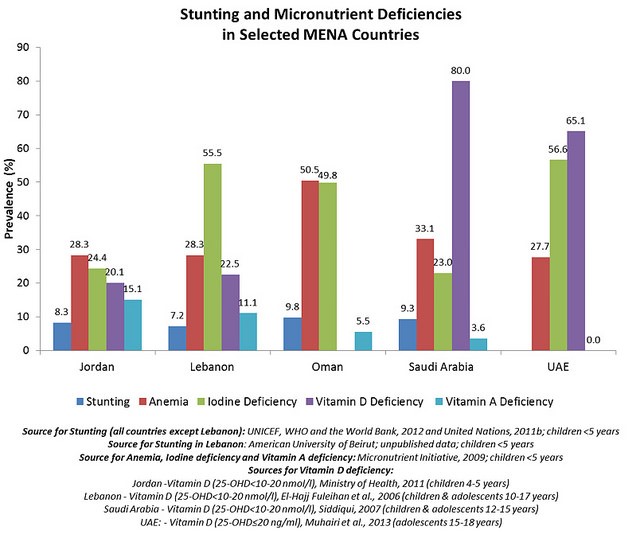Food security does not guarantee ‘nutrient security’
Although food security encompasses availability, accessibility, utilization, and stability, nutrition security is often neglected. Nutrition security is an essential element of food security, and because sound nutrition requires more than just enough energy for every man, woman, and child, human needs can only be satisfied through a diversity of macro- and micronutrients to ensure good health and prevent disease.
The MENA region suffers from nutrient deficiencies, even in relatively wealthy countries. Adequate energy availability and intake is insufficient to ensure food security as both rich and poor countries in the region simultaneously exhibit nutrient insecurity in the form of stunting, overweight and obesity, through micronutrient deficiency. Currently in the MENA region, many policies, programs, and strategies addressing food security are skewed towards agricultural production and food availability and do not address challenges in the accessibility and quality of the food consumed by the population. Nutrient security within the four dimensions of food security Nutrition should be a pivotal part of all the four dimensions of food security. Having said that, all policies and programs that address the availability, accessibility, utilization, and stability of food security should cover both macro- and micronutrients.
Availability
When addressing food availability – or agricultural production – we need to consider the quality as well as the quantity of the nutrients considered. Nutrition-sensitive agricultural programs show promise by providing economic advantage and by supplying more diverse and nutritious diets, thus directly improving food security. For example, farmers can produce bio-fortified rice varieties containing more iron and zinc and/or supplement fertilizers with zinc as efficient strategies to improve plant micronutrient content and alleviate micronutrient deficiencies.
Accessibility
Food accessibility may be achieved through own-production, purchase, or by receiving food assistance. However, all these channels must deliver and/or encourage the provision of safe and nutritious food. Subsidy programs can play a significant role in making nutrient-rich foods more accessible to households and individuals and subsidy reforms that improve both energy consumption and nutrient diversity are an important step towards nutrition security.
Utilization
Nutrition is mostly related to the utilization dimension of food security. Food security policies and programs must ensure that every individual can consume safe and nutritious foods. As Fan notes, micronutrient deficiency does not exist in isolation but can occur simultaneously with undernutrition, and overweight and obesity, at the level of individuals and across populations both, in poorer as well as in richer countries. That is why increasing nutritional awareness should not only target poor countries or populations - who may predominantly face gaps in reaching energy or nutrient requirements - but also target richer countries that suffer from nutrient deficiencies even when their energy intake is excessive. For example, as shown in the graph below, richer Arab Gulf countries, show a high prevalence of anemia and iodine, and Vitamin D deficiencies. Their stunting prevalence is also high despite an energy intake that leads to overweight and obesity. Nutrition education and awareness programs like community-based interventions targeting school-aged children and adults can emphasize safe and nutrient-dense foods and help individuals make optimal, healthy food choices.

Stability
The macro- and micronutrient content of food are crucial when considering the stability of food security. Emergency feeding programs must ensure that needy individuals receive food baskets or voucher-based assistance that deliver critical macro- and micronutrients. For example, providing refugees or the underprivileged with staple foods such as oil, sugar, and flour may help meet energy needs but does not directly deliver protein and micronutrient diversity needed for adequate growth and maintenance, and could potentially contribute to nutrient deficiencies that impact the growth of children and the health of adults.
Achieving nutrient security
Nutrient security must be embedded in all national policies, programs, and strategic plans that address food security. Having nutrition as an essential component of food security will guide subsidies policies and programs, and will also inform and direct programs and policies towards nutrition-sensitive agriculture that considers both farmer and consumer needs. The UN Standing Committee on Nutrition’s efforts to gather and disseminate Key Recommendations for Improving Nutrition through Agriculture are important contributions, and further testing and revision of these recommendations should be undertaken within the MENA region in the future. In order to achieve this, policymakers should be sensitized to nutrition security and its relevance to all the four dimensions of food security. Governments and ministries should engage in policy dialogue about nutrition for food security, allocate sufficient funding for programs across all the four dimensions of food security, and also be held accountable for achieving positive nutrition outcomes throughout the full range of food security programs.
Nahla Hwalla (Dean), Rachel Bahn (Director of Food Security Program), Sibelle El-Labban (Senior Research Assistant) – Faculty of Agricultural and Food Sciences, American University of Beirut